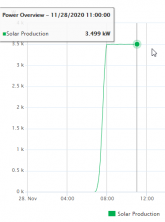On a sunny day, in November, with 30, 310W panels facing mostly south in Northern Illinois, I'm getting this plateau right at 3.5kW, way early in the morning (see graph).
If it peaked midday-ish, I might not be concerened. I'm new to this (2 weeks in), but so I'm not even sure what to expect. When I google production of a 300W panel it says 3.5kWh in a 8 hour sunny day. To me it seems like I'm way under producing even accounting for November Illinois.
Further, the exact plataeu of 3.5 kW on several days, way early in the day, almost makes me suspect something is limiting production. I have a Solaredge se10000H I believe, which shouldn;t cap out at 3.5kW. Right?
Any other reasons for teh 3.5kW early plateau with 30 * 310W panels?

If it peaked midday-ish, I might not be concerened. I'm new to this (2 weeks in), but so I'm not even sure what to expect. When I google production of a 300W panel it says 3.5kWh in a 8 hour sunny day. To me it seems like I'm way under producing even accounting for November Illinois.
Further, the exact plataeu of 3.5 kW on several days, way early in the day, almost makes me suspect something is limiting production. I have a Solaredge se10000H I believe, which shouldn;t cap out at 3.5kW. Right?
Any other reasons for teh 3.5kW early plateau with 30 * 310W panels?




